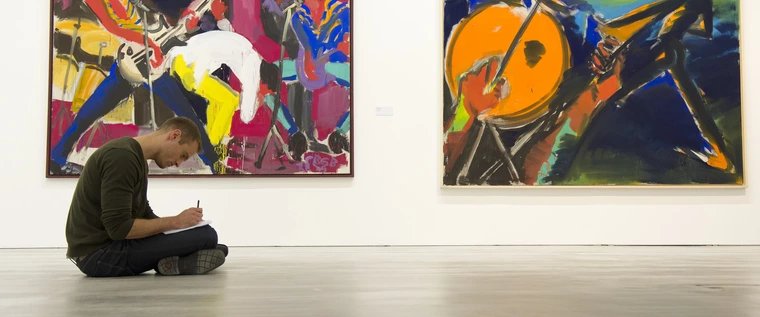
Early drawings and prints
The special exhibition is dedicated to a special period in the decades-long work of an artist who was born in Berlin and has lived in Pankow since 1952 - the artistic weaver Ingeborg Flierl, née Millies. She holds an unmistakable place in the textile art of the GDR. Her work includes more than 200 tapestries, numerous appliqués, prints and building-related ceramic works.
After 1945, Ingeborg Millies did not take up the profession of farmer that she had just learned. The passionate draftswoman was drawn to studying art. The 20-year-old autodidact enrolled at the traditional Academy of Fine Arts in Berlin-Charlottenburg. She initially studied painting and sculpture, until she finally moved to the Applied Arts department in 1951. Here she turned to textile art.
In 1952, Ingeborg Millies and her boyfriend, architecture student Peter Flierl, were among the signatories of a petition against the German Treaty between the Federal Republic of Germany and the three Western Allies. This provided for the rearmament of Germany and its inclusion in the Western alliances. Since they did not withdraw their signatures, they were politically expelled from the Charlottenburg University.
Both then moved to the East Berlin district of Pankow in 1953 and got married. An open circle of friends of like-minded artists formed around the Flierls. In the climate of the state-initiated formalism debate against the Western cultural establishment, they came together.
The exchange with friends and colleagues enriched and inspired the young Ingeborg Flierl, who now worked freelance as a draftsman, graphic artist and textile artist and raised their four children “on the side” over the next ten years.
Between 1956 and 1961, Ingeborg Flierl lived with her family in the middle of Prenzlauer Berg, on Kollwitzplatz. The studio apartment was allocated to her by the artists' association and was located in the attic of the house at Knaackstrasse 45. After laborious clearing work, the war rubble in the area has been cleared away. But the trees on the square survived the cold post-war winters without being cut down.
The square becomes a meeting place for many people. Ingeborg Flierl observes and portrays normal, daily life and her own everyday life. At the same time, she also draws more distant city motifs in Mitte and Friedrichshain, including views of destroyed cultural sites such as Schinkel's concert hall. To do this, she puts the pencils aside, picks up a pen, brush and ink, and turns to printmaking techniques, especially lithography. In this way, Ingeborg Flierl captures the special atmosphere that was typical of the long post-war period in East Berlin - between the years of war survived and a new courage to live.
The special exhibition presents these previously unknown drawings and prints. They came to light when Theresa Flierl was compiling the catalogue raisonné and are being shown publicly here for the first time.
Supported by the District Cultural Fund.


